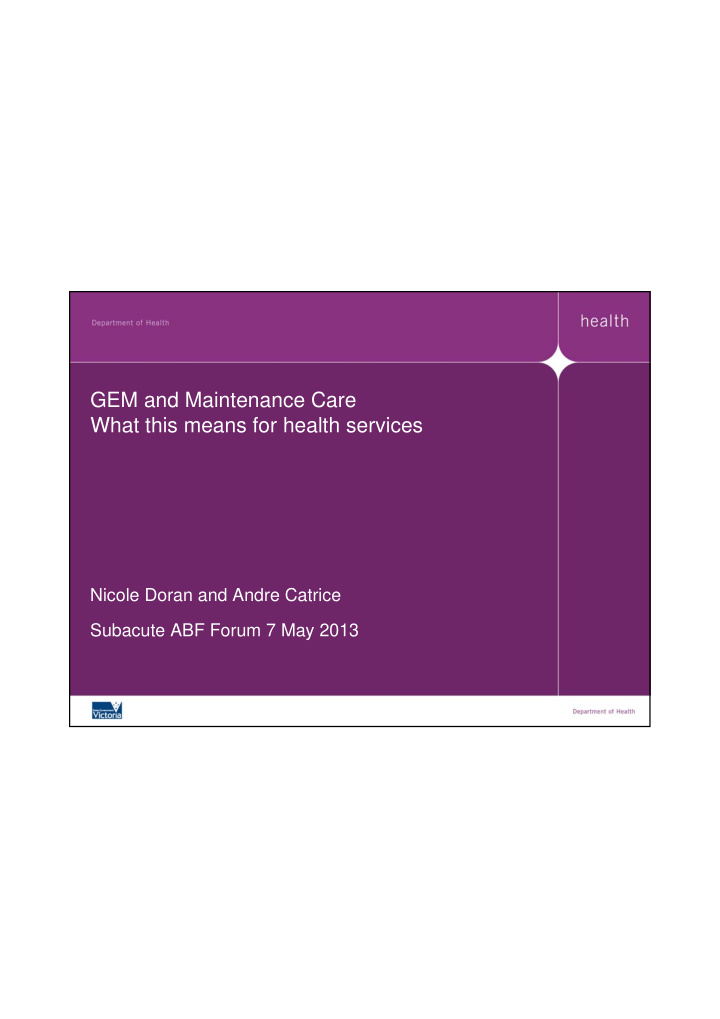



GEM and Maintenance Care What this means for health services Nicole Doran and Andre Catrice Subacute ABF Forum 7 May 2013
What we will be discussing Drivers for change Why are we introducing these changes What are the changes How these changes will effect health services Improving models of care
What do we want to achieve Care centred around needs of patient rather than funding Focus on holistic care • Improving care for older people • Reduce functional decline in hospital • Flexibility • Simplify care pathways • Care provided in the least restrictive setting – home first • Services align with the Subacute Service Capability Framework
Guiding Principles • Person and family centred • Specialist care • Multidisciplinary coordinated and goal focussed care • Individualised discharge planning • Restore or substitute for lost function • Promote independence • International Classification of Function - Body functions and structures - Activity limitations - Participation restriction
What the changes look like Metropolitan, regional and sub-regional health services will report GEM Local Health services will report maintenance care No change for small rural health services
How will this effect you - GEM What is GEM Geriatric evaluation and management is care in which the primary clinical purpose or treatment goal is improvement in the functioning of a patient with multi-dimensional needs associated with medical conditions related to ageing, such as falls, incontinence, reduced mobility, delirium and depression. The patient may have complex psychosocial problems and is usually (but not always) an older patient. Geriatric evaluation and management is always: • delivered under the management of a clinician with special expertise in geriatric evaluation and management • evidenced by an individualised multidisciplinary management plan, that is documented in the patient’s medical record, which includes negotiated goals within indicative time frames and documented assessment of functional ability.
How will this effect you - GEM All GEM and restorative care activity targets and associated funding will be rolled up together and reported as GEM • Flexible care settings to provide GEM in the setting that best reflects the patients care needs. • Opportunity to review how care for older people is delivered • Current service arrangements can stay in place • Only one weighted bedday • Report as for care type 9
Maintenance Care What is maintenance care Maintenance (or non-acute) care is care in which the primary clinical purpose or treatment goal is supportive for a patient with a severe level of impairment, activity limitation or participation restriction due to a health condition. Following assessment or treatment the patient does not require further complex assessment or stabilisation. Patients with a care type of maintenance care often require care over an indefinite period.
How will this effect you - maintenance care All GEM and restorative care activity targets and associated funding will be rolled up together and reported as maintenance care In ‘Local’ health services previous NHT activity will be reported as maintenance care • Flexibility to provide care in the setting that best reflects the patients care needs. • Opportunity to review how care for older people is delivered • Variety of settings – hospital, home, residential care • Current service arrangements can stay in place • Only one weighted bedday • Report as care type R1 (on health service site) or R2 (off site) in the interim
Best care for older people everywhere The toolkit (2012) Improving care for older people Evidenced based support or a ‘how to’ guide • Identified tools for assessment • Training resources • Information for patients and families • Number of domains of care from common geriatric issues to person centred practice • Updated 2012 with additional domains including advanced care planning
Transition Care Program Provides short term-support and active management for older people at the interface of the acute/subacute and aged care (ie community and residential) sector. Maintenance care should be considered where person is ineligible for TCP , access is limited, or to facilitate assessment for TCP Optimise function and finalise long term care plan • Case management • Low level therapy • Nursing support • Time • Promote independence
Improving outcomes for older people in hospital Towards best care Principles • Least restrictive • Reduce transition points • Earliest definitive care • Holistic • Safe but not risk averse • Person and family centred • Reduce unnecessary hospital days • Reduce risk of re-presentation to hospital
Improving outcomes for older people in hospital What might GEM care look like? • Specialist medical, nursing and allied health team • Comprehensive geriatric assessment • Integrated across settings Key is screening all older people to identify issues requiring a GEM approach to care.
Improving outcomes for older people in hospital What might GEM care look like? In acute, subacute, hospital, home, residential care Some scenarios: • ED Home with rapid GEM follow up • ED GEM D/c with GEM/HIP/TCP follow up • ED Acute D/c with GEM/HIP/TCP follow up • ED Acute GEM D/c with GEM/HIP/TCP follow up • Home GEM D/c with HIP/TCP follow up
Improving outcomes for older people in hospital What Maintenance Care might look like? • Focus on specific needs of older people • Assessment (looks like need to move to RUG-ADL) • Care coordination • Allied Health - low intensity therapy • Nursing support • Time to improve • Promote independence (personal and environmental)
The hospitalised older person journey Key is…… screening all older patients at point of entry to determine need for comprehensive geriatric assessment
Recommend
More recommend